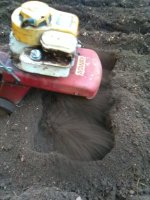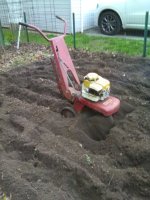My thoughts on your above thoughts:
1) the tea leaves can go directly into the garden or can be composted...just depends on how fast you want the nutrients to be used by your garden plants.
I've read both that tea leaves in the garden 'uncomposted' could reduce nitrogen just like adding uncomposted leaves pr grass would?
I just don't see them being that bad because of how finely ground these are and they would likely break down fast. The grounds are dry and pretty finely ground when I get them, about half the consistency of coffee grounds, after a run through the hammer mill they're the consistency of corn meal or finer.
It seems I can have an endless supply of tea grounds too, several buckets a week if I wanted them.
2) your use of cover crops is a good thing but could/should be expanded to include other types and used for aids in rotation/soil building. Rotation is absolutely critical if gardening in same location year after year.
I've always used barley because its what i get free. A buddy uses it on his farm fields, and gets it in bulk, I only need a few handfuls of seed to cover my whole garden here, he spills more of it then I use.
I never much thought of using anything else mainly because it was always a free and easy to obtain solution.
3) I don't see the large variability you seem to have in your soil tests. The N2 seems to be most variable and needing to be replenished often but P, and K and micronutrients are surprisingly stable in my space...and many years we have more than 60 inches of rain. Getting a good diverse sample is very important as results can indeed vary within the same garden space.
I send out a soil sample every so often just to check, its never been really bad, but the weak point is always nitrogen, and sometimes calcium. Its never horrible but they recommended adding nitrogen rich fertilizer and lots of lime.
The presents of blossom end rot almost every year in the first few tomatoes to ripen sort of confirms this. This is even with me putting several bags of lime on a 20x20ft garden every spring and one just before planting the cover crop in November.
I have the best results using high nitrogen fertilizer, the plants are healthier overall and I get few mid season issues.
4) I personally don't use much if any commercial synthetic fertilizers but instead rely on my own proven organic methods. As a result, Nitrogen is something I'm constantly seeking to improve on. I have found incredible results using alfalfa in a rotation program...increasing soil Nitrogen as measured in soil tests by over 200%. This summer I'm trying out Sunn Hemp which is reputed to be even more effective at Nitrogen fixing than alfalfa.
I'd like to avoid all synthetic fertilizer but have never been able to.
I save every last bit of my fall leaves, grass clippings, and kitchen waste for the compost and I turn under the last seasons mulch but soil tests always show nitrogen levels fairly low early into the season.
The soil ph stays around 5.8, even large amounts of lime don't do much but prevent it from dropping lower.
calcium was around 300 the last test last July and nitrate was 41ppm that will be lower now. Organic matter was at 6.0. Magnesium was at 310. Iron was at 101. The report was through a service provided to local growers.
I was told that I need to add nitrogen and calcium but the ph was okay for tomatoes. The one side of the garden gets more shade from a nearby tree and an nearby shed, that area always reads higher in nitrogen and its where I used to plan lettuce and other leafy vegitables.
I gave up on those because I got tired of fighting the ground hogs. When I stopped growing lettuce, spinach, and such the ground hogs went away. They either starved or died from lead poisoning.
I grow Tomatoes, usually about 24 plants, about 6 of which are Better Boy or similar, the rest are plum tomatoes for sauce.
I do a full row of pickles and a row of zucchini and a half dozen or so Jalepeno plants. I did peas in the past but last year they were so bad and this year we had a late winter so I didn't bother. The weather turns too fast here and lately they haven't amounted to much. This year, in the shaded part of the garden I planted a row of sunflowers and two rows of Okra. (I've had problems with ants in the past with okra so I've not done any in about four years). I got a bag of free seeds so I'll be putting in at least two rows. Its always been very productive here.
Two things I avoid here, one is grape tomatoes, the other is seedless cucumbers.
I planted two grape tomato plants 12 years ago, I've been fighting back wild grape tomato plants all over the yard ever since They've become like a plague, all from two plants that ran wild all those years ago. Three years ago I put in two cucumber plants that a neighbor was going to throw away. I planted them both in one tomato cage as an experiment, but Sept, they had taken over more than half the garden. I found runners shooting all over the yard and was finding supersized cucumbers that escaped picking when I pulled up the plants in Nov. One was growing almost 20ft from the garden under a boat trailer. It was the size of a watermelon when I found it.
I stick with Kirby pickles now and keep them spaced well away from other plants.
Two years ago I planted Kirby pickles from a flat of plants I got at the local farm supply. It was a flat that got dropped and left in the parking lot. I picked it up and planted about half the plants in that tray. What I found out was that it was half Kirby pickles and half zucchini. I had planted the plants two and three per cage assuming they were pickles. To my surprise, the zucchini grew in the cages very well. I had 6ft tall zucchini plants that grew in stages up the inside of the cage. The plants never got any powdery mildew, they didn't rot from ground contact and the production was insane. The plants growing up high in the cage also kept groundhogs from eating the blossoms as well.
I had always done zucchini on small mounds or hills in threes but by late July the plants would either get mildew or the stems would rot from ground contact as the winding stems got further from the parent plant. In the cages, the plant just kept adding on and going upward. The base stem got huge, it was like a tree trunk by the time I pulled out the garden that Nov.




